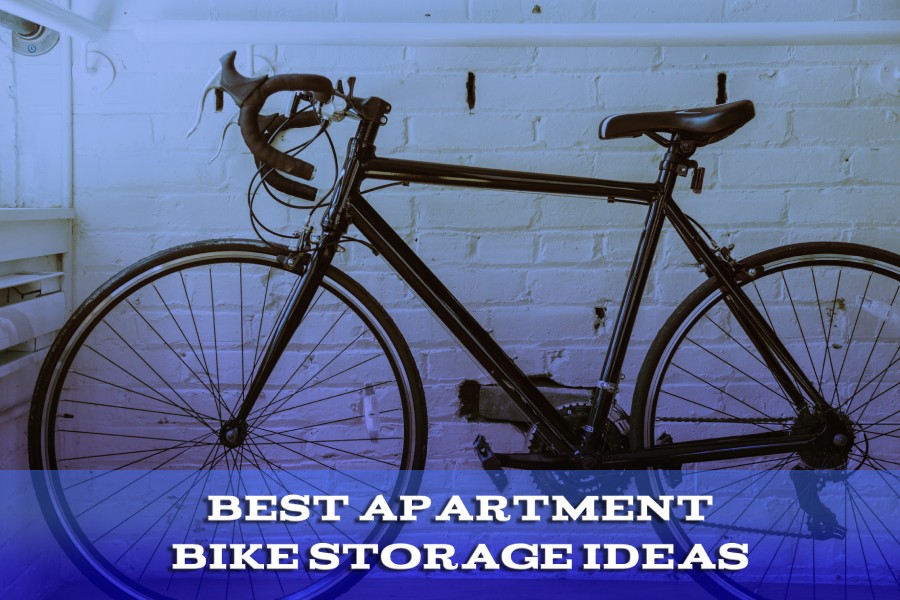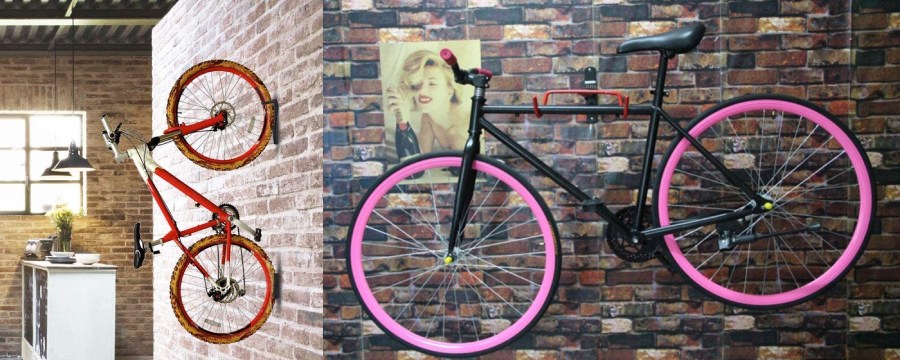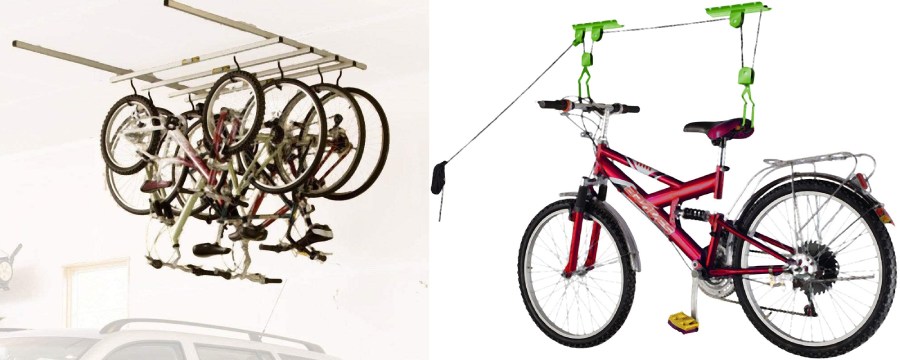
Most people don’t have access to a garage or secure garden and must creatively utilize the space in their apartment with an indoor bike storage idea.
There are several solutions to choose from, all of which have advantages and disadvantages. Because the storage is inside the home, it’s important that it saves space, and is practical, visually appealing, and tidy.
This article will help you choose the perfect apartment bicycle storage ideas by asking a few short questions, followed by a description of each type and its pros and cons.
Things to Consider Before Choosing
Before learning about the actual home bike racks, determine your needs and preferences by asking yourself the following questions.
How much free space do I have? / How is the free space laid out?
The size and layout of your free space are arguably the most significant factors for determining the best storage solution. For example, if you have a regular small apartment, a horizontal bicycle wall mount or supported stand may be the only one that fits.
For medium to large size homes with more free space, vertical bike storage allows you to store three or more bikes very efficiently. Other bike storage solutions, like ceiling racks, creatively utilize space but require high ceilings and aren’t aesthetically appealing.
How many bikes do I want to store?

Each bike storage rack and stand has a capacity range that maximizes functionality and convenience in an apartment.
- One bike: Wall bike hooks, a pulley-operated bike hanger, bike furniture, vertical hooks
- Two bikes: Telescoping poles, wall stands, stacked hooks
- Three+ bikes: Freestanding floor racks, horizontal bike storage, vertical bike stand, ceiling racks
Depending on the number of bikes you need to store, you can shortlist some of the storage options above.
You should also think about any additional bike gear and accessories you need to store, such as a helmet, glasses, clothes, spares, and electronics.
Choosing Between Practicality vs. Aesthetics
No matter which solution you choose, there will be a trade-off between practicality and aesthetics.
Therefore, you need to determine what is more important for you, as this will affect your final choice.
- Aesthetic: A horizontal wooden bike rack may look great and show off your bike but is impractical.
- Practicality: A vertical wall rack is super-practical but may appear unappealing.
- A balanced approach: A horizontal indoor bike stand balances functionality and style for most users.
How often do I use the bike(s)?

Choose a vertical instead of a horizontal wall mount if you ride regularly.
If you use your bike daily, such as for transport or commuting, something convenient to access that allows easy mounting and unmounting of your bike(s) is essential. Examples include floor racks and vertical or horizontal racks.
For less-frequent use, like weekend and leisure cycling, convenience may not be as high a priority. Suitable choices in this situation are pulley-operated ceiling racks or some horizontal wall-mounted bike storage products.
How much money am I willing to spend?
You can choose from a wide range of products and prices in most of these categories.
Generally, bike furniture, ceiling storage, high-capacity vertical storage, and handmade/aesthetic products are more pricey; individual wall hooks, floor racks, and freestanding racks are more affordable.
Therefore, you need to consider your budget and whether you simply want something that gets the job done or also looks good and has a premium feel
How much weight can the bike rack support?
The typical weight limit for wall-mounted racks, supported stands, and freestanding racks is around 40-50 pounds. That’s more than enough for most types of bikes out there.
Exceptionally heavy bikes, such as cargo bikes, or electric bikes over 50 lb will require a solution with a higher weight limit or without a weight limit, such as a parking floor stand or a vertical floor stand.
Am I willing to put screws in the wall?
For homeowners, drilling holes may not be an issue. However, renters are often unable to make permanent changes to the wall.
In this case, choose a freestanding or supported floor stand that doesn’t require drilling for installation.
However, if you can drill holes in the drywall, this will open up more options for you, many of which are highly practical and aesthetically pleasing.
Though a lot of wall bike hangers come with drywall anchors, we recommend drilling into the stud to prevent the rack from collapsing.
Wall-Mounted Bike Storage Options
Vertical Wall Storage

Image: Amazon
- Best for 3+ bikes
- Broad compatibility
- Effortless loading/unloading
- Can go anywhere in the apartment
- Unobtrusive
- 2+ installation points
- Inefficient for 1-2 bikes/small spaces
- Take up a lot of space
- Require drilling
- May not fit small wheels
- Can be expensive
Of all the wall-mounted options, vertical storage utilizes space most efficiently for more than three bikes by storing bikes side by side in a row on individual cradles or on a high-capacity rack.
Most vertical wall storage solutions allow effortless mounting and unmounting and are minimalistic in design.
Generally, the bike’s front tire and wheel rest in the top cradle that supports the weight of the bike and is coated with rubber to prevent damage to the wheel. The bottom piece (if there is one) cradles the rear wheel, mainly to keep it from touching the wall, as gravity does all the rest.
Because these racks use a wheel cradle, wheel diameter and tire size may limit compatibility; some models are also incompatible with fenders.
This method can take up a lot of room as the bicycles protrude more from the wall, making vertical storage practical in spacious rooms.
One helpful feature of some products is the ability to swing, pushing bikes closer to the wall and freeing up valuable space.
Horizontal Wall Storage

Image: Amazon
- Cheap
- Widest choice of products
- No floor space needed
- Easy, minimal installation
- Allows you to display a bike
- Install anywhere with free wall space
- Drilling necessary
- The top bicycle is hard to reach
- No heavy bikes
- Requires lots of wall space
- Max two bikes
- Top tube compatibility issues
Horizontal wall racks are an excellent choice for small apartments because they free up valuable floor space by making use of the less functional wall space.
Most commercial horizontal storage products consist of two hooks on a bracket that you drill into the wall. They hold your bike by the frame, specifically by the top tube.
These are pretty minimalistic in design but not always very aesthetic. However, there are some products that double as a shelf for books or other times, offering extra storage space and being more aesthetically pleasing.
Hooks are an affordable and compact storage method, and by stacking two sets of hooks, you can store two bikes, one over the other (the top bike will be harder to reach, though).
Unfortunately, this limitation means they’re not practical for more than two bikes.
Floor Bike Racks

Floor bike racks come in four designs: freestanding, telescoping, parking-style racks, and bike bags.
Parking Rack / Floor Stand
- Easiest and fastest access to bikes
- Zero installation
- Hold up to 6 bikes
- Affordable
- Some products have extra storage
- Poor use of space
- Can be unstable
- Limited compatibility with some wheel sizes/tire widths
- Not visually appealing
Parking-style floor racks are typically built from steel and support the front wheel in a slot to keep the bike upright and in line, as you would outdoors.
Placing the wheel in a slot can limit compatibility with large wheels, kids’ wheel diameters, wider tires on mountain bikes, or disc brakes. Some stands are multifunctional, with shelving added over the bikes.
While these racks are great for keeping bikes organized while maintaining quick and easy access, they use space inefficiently, restricting their use to large apartments. Additionally, they aren’t aesthetic, which lessens their appeal for apartment use.
Telescoping Bike Racks
- Affordable
- No drilling
- Can move anywhere in the apartment
- Compact and space-efficient
- Easy to use
- Ceiling height limitations
- Top bike is more difficult to load
- Limit of two bikes
- Incompatible with some ceiling materials
- Weight limit
Telescoping racks are poles that push against the floor and ceiling to support the weight of the bikes. They do so by extending upwards to the ceiling with a twisting mechanism.
These poles generally hold two bikes horizontally, allowing you to maximize the wall space. The compact design works great in a small to medium size apartment.
The poles are neat-looking and straightforward, making them a good choice for the aesthetically-minded cyclist. In addition, they have a bike weight capacity of 40-50 lbs per bike, rwhich is more than enough for most bike types, except for very heavy e-bikes and cargo bikes.
Freestanding Bike Racks
- Zero installation required
- Inexpensive
- Great compatibility
- Easy to move
- Choice of two or four bikes
- Difficult to load the top bike(s)
- Some products have limited top-tube compatibility
- Weight capacity
- The wide base takes up more space
Technically, a freestanding rack is any rack that doesn’t require installation or additional support.
Freestanding racks are like coat racks for bikes and are a great solution for small or medium-sized apartments as they can go anywhere and are relatively compact.
Typically made from steel, freestanding racks have wide bases for balancing and fit two or four bikes. Most products on the market look good and are unobtrusive but are not very aesthetic when loaded, especially the four-bike versions.
Bike Storage Bags & Covers

Image: Amazon
- Compact
- Protective
- Portable
- Ineffective for most people
- One-bike capacity
Bike storage bags are typically used for transporting individual bikes on planes and public transport. However, they can double as storage for old or unused bikes in small apartments.
These bags use heavy-duty outer material with reinforced sections to keep the bike safe from damage in transit.
In addition to that, you can also get an affordable bike storage cover that acts as a sock for your bike, allowing you to keep it in your room without damaging or greasing your furniture.
Ceiling Bike Storage

Ceiling bike storage is excellent for garages, but not for all apartments.
- Very efficient use of space
- Free up wall/floor space
- Multi-bike racks are easy to access
- Pulley-racks don’t require lifting
- Expensive
- Laborious to set up
- Drilling required
- Need high ceilings
- Pulleys are time-consuming to use
- Pulleys limited to one bike
Ceiling bike racks (also known as hoists) are a clever way to utilize ceiling space that typically goes unused. There are two distinct styles:
- Pulley-operated single-bike hangers
- Multi-bike racks
Pulley systems use two ropes with hooks to secure the handlebars and saddle. The ropes wind in, pulling the bike overhead with minimal effort.
Multi-bike ceiling racks can store up to six bikes. They use two independent hooks to hold the bikes upside down by the wheels. Unfortunately, this requires manually lifting the bikes, which isn’t helpful when used with heavy bikes, or when operated by kids or shorter people.
Neither of the two types is very aesthetic and both require high ceilings to install the system with enough space for the bike to hang, meaning they are best for large apartments or houses with garages.
Indoor Bike Storage Furniture

Image: Instagram @chol1_cl
- Efficient use of space
- Stylish
- Easy to access
- Potentially free
- Could ruin the furniture
- Need DIY skills
- Must own the furniture
- Unsuitable for renters
Indoor bike storage furniture usually involves creatively modifying your existing furniture to double as bike storage.
These DIY ideas are excellent for single bikes and small apartments. In addition, they are very visually appealing. However, most cyclists can’t or don’t want to modify their furniture for this type of use.
There is also ready-made bike storage furniture that you can buy or build specifically for the purpose of storing your bikes. It looks great, but it often takes significant space and may cost a lot to purchase or make.
These are especially good for high-end road bikes or gravel bikes that could add to the appeal of your space.
Apartment Bike Storage Tips and Tricks
Storing your bike inside is pretty straightforward, but here are a few pieces of advice to help everything go smoothly and stay clean.
- Reverse the direction of each bicycle to avoid handlebar contact and balance the load.
- Don’t lean your derailleur(s) against anything.
- Place cardboard, plastic, or some other material on the wall if necessary, to avoid marks.
- Maintain a clean bike. A quick cleaning every 2-4 weeks or a quick wash each time you ride in the mud keeps dirt and debris outside.
- Maintain proper air pressure in the tires at all times to avoid damage to the tubes, tires, or rims.
In summary, storing your bike indoors requires careful consideration not only to preserve the condition of the bike but also to maintain the cleanliness and integrity of your living space. These simple yet effective steps can greatly enhance your indoor bike storage experience, keeping your space organized and your bike ready for your next adventure.
Final Thoughts About Apartment Bike Storage
Storing bikes indoors is essential for many cyclists, as outdoor storage can be unsafe or unavailable and may require expensive locks and security measures.
For those with limited room, utilizing the available space efficiently is vital. However, for larger apartments, aesthetics or convenience may take priority.
Choosing the perfect storage solution for your home can be daunting with so many options. Remember, the key things to consider are:
- Size and layout of the free space?
- Practicality or aesthetics?
- Frequency of use?
- How many bikes do you have, and how much they weight
- Is drilling the drywall an option?
- What is your budget?
With these six points clarified and the pros and cons in mind, you can select the perfect apartment bike storage for your space.
Then, whichever one you pick, follow good storage practices, and you’ll be guaranteed to store and ride your bikes effortlessly for years to come.


